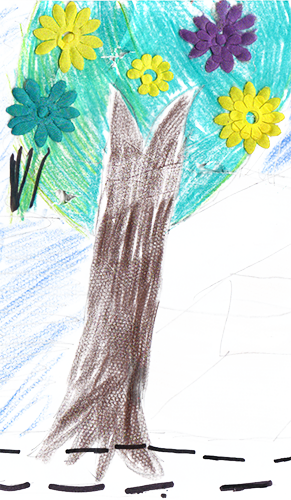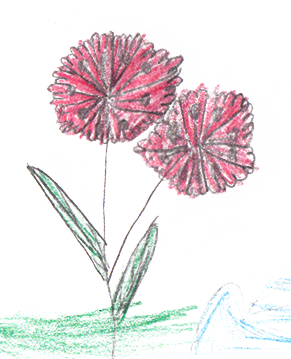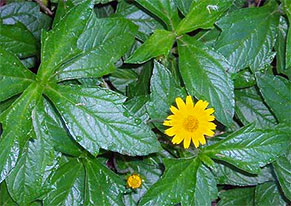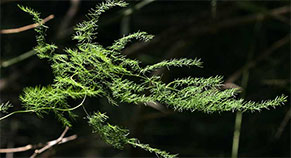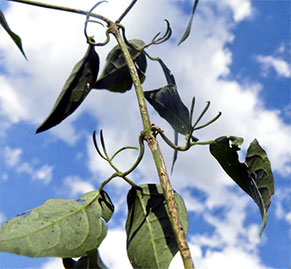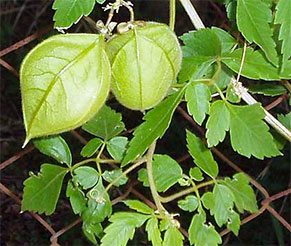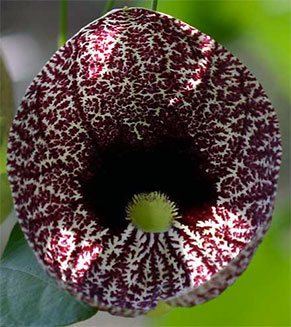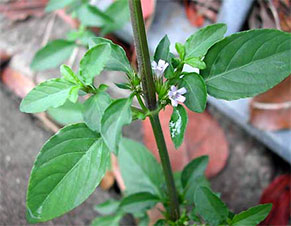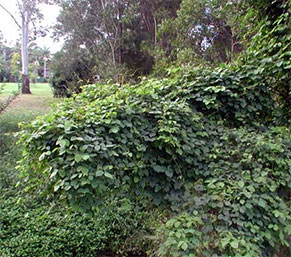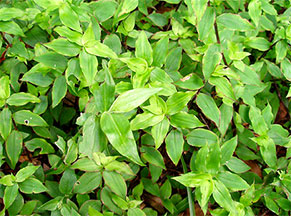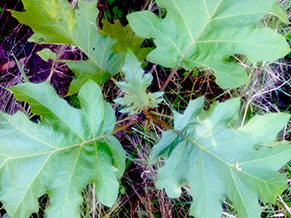
Addie, age 5
Weeds at Fish Creek
What is a weed?
A weed is any plant growing in a place where it is not wanted.
What are some of the features of a weed?
As well as being a plant growing where we do not want it to, weeds generally share some characteristics that can make them harmful. Some features of a weed include:
- Being able to adapt very easily to new soils and different soil types.
- Being able to survive just about anything! Weeds can grow in and adapt to a variety of conditions. They can often survive relatively extreme ranges in temperatures and differing amounts of rainfall. A lot of the time, weeds don’t mind if the environment is disturbed.
- Being able to reproduce easily. Weeds usually produce large numbers of seeds or have an ability to spread easily throughout an environment. This may be through vines or tubers that spread under the ground.
How did the weeds get here?
Many weeds are plants that were brought into Australia over the past 200 years. Over much of this time, people did not realise that bringing plants into Australia could harm our native environment, hurt people or animals and have a negative impact on our economy. Sometimes plants were brought into Australia because people thought the plant looked pretty. Other times, people thought the plant would be useful. Most of the time, people simply did not realise that bad things could happen if and when they placed that plant into their garden or local environment. Nowadays we are more aware of how bringing plants into Australia from overseas could be harmful. There are now special laws in place to stop people from bringing plants from overseas into Australia without permission. Authorities such as Australian Quarantine and Inspection Service and Customs work very hard to stop people from bringing plants or animals into Australia that could hurt our environment, animals, people or economy.
Can a native plant be a weed?
Yes. Remember, a weed is any plant that grows where it is not wanted. Native plants can sometimes be a weed.
Why are weeds a problem?
Weeds are a real problem for all of us because:
- They can grow very quickly and outgrow and take over native bushland, just like what was happening in Fish Creek before we started to take care of it;
- They can be poisonous to native animals if they eat them;
- They hurt our economy. Farmers and people working in the agricultural industry have to spend lots of money and time trying to keep their land and crops free from weeds;
- They can make people sick by causing skin rashes and allergies;
- They can reduce water quality;
- They can stop us having fun! Weeds can block waterways and can reduce our enjoyment with activities like canoeing, fishing, hiking and camping;
- They can increase the risk of fire when we have a dry season with little rain.
Unfortunately, all over Australia weeds are spreading faster than they can be controlled. Worse, the impact of weeds on our environment is increasing on a yearly basis. Exotic species (plants that come from outside Australia) now account for approximately 15% of all flora and this figure is going up by about 10 species each year. There is no doubt that weeds have become a real problem. Luckily, there are things we can do that will help to reduce this problem.
I want to help! What can I do?
While there is no absolute cure to eliminate weeds from around our local area, there are things that you can do to help limit their growth and improve our environment. One of the best ways you can help Fish Creek to stay healthy is to remove weeds growing in your own garden at home. This is because weeds often have a sneaky ability to travel distances from the original plant via wind, underground tubers or by birds transporting and dropping the seeds of the weed plant into other areas of land. Here are five easy steps you may like to follow that will help to reduce the number of weeds growing around our local community:
- Learn how to identify weeds. Know how to tell which plants help our environment and which plants can cause harm to our environment. This is the first step to a healthier, happier environment! We have featured a few nasty weeds found around Fish Creek on this website. If you need further information, you can also visit our Further Reading page to find more resources that will guide and help you learn how to identify weeds that grow in our local area and around Australia.
- Find out the best way to remove a weed. Sometimes weeds are small and can easily be removed by hand. At these times, getting rid of a weed is easy and you can do it straight away! Other times, a weed could be a big plant, be poisonous or covered in prickles or thorns. These weeds need to be removed by an adult. Sometimes an adult may need to use a saw or even a chemical called a herbicide. A herbicide is sometimes used to make sure the plant is properly killed. Remember – always ask an adult before you touch a plant!
- Remove the weed. Once you have worked out the best and safest way to remove the weed as well as who should remove the weed – go for it!
- Dispose of the weed responsibly. You have done a great job removing the weed – please do not then go and hurt our environment by dumping the green waste over the back fence or out into bushland. Visit our Further Reading page to find information about the best ways you can get rid of your garden or green waste so that it will not harm our environment.
- Join others! Become a member of your local environmental or bushcare group. Around our local The Gap area, we have many community organisations doing great work to care for our local environment, such as Habitat Brisbane, Balaangala Community Group and Save Our Waterways Now. These community organisations will always welcome new members warmly. Go on, give them a call! You can also find their contact details in our Further Reading page.
Singapore Daisy
Sphagneticola trilobata (ASTERACEAE)
Native to South America, Singapore Daisy is a weed that has invaded much of Fish Creek. It is such a problem plant that it has now been declared a Class 3 species of weed. The main problem with this particular weed is that it has very dense growth that smothers native plants. It can also be very difficult to remove.
Climbing Asparagus
Asparagus africanus (ASPARAGACEAE)
Native to Southern Africa,the hardy Climbing Asparagus can quickly establish and has the ability to smother trees. Declared as a Class 3 pest in Queensland, this plant was growing all over Hilder Road State School’s section of Fish Creek before restoration was commenced. Climbing asparagus can grow to 15 metres tall if it has a tree to support its growth and is very easily spread by birds and dumped garden waste. The weed has masses of inter-connected roots that can make it difficult to remove and is full of thorns – you should wear long sleeves and long trousers if you are trying to remove this weed from your garden.
Cats Claw Creeper
Macfadyena unguis-cati (BIGNONIACEAE)
Cats Claw Creeper is native to the Brazil and Argentina. Originally introduced into Australia as a garden plant, this plant is a creeper that can grow to 30 metres. It grows quickly and can smother and pull down tall trees or can grow as a ground cover along the forest floor stopping native plants from growing. This plant has been ranked as the fourth most invasive alien plant species in South East Queensland and is identified as a Weed on National Significance.
Madeira Vine
Anredera cordifolia (BASELLACEAE)
Native to South America, Madeira Vine is a soft, fast-growing plant that has heart-shaped leaves. It can completely engulf native species and reduce light penetration to lower storey plants. Reduced light penetration means the plants closer to the ground do not get enough sunlight. The native plants close to the ground can die because of this. Unfortunately, native vines simply cannot compete with the madeira vine’s incredible growth rate. The plant can be difficult to control as new vines can sprout from even fragments of tubers and standard herbicides are not very effective. Madeira vine is a Class 3 declared pest under Queensland legislation
Balloon Vine
Ardiospermum grandiflorum (SAPINDACEAE)
Balloon Vine is native to tropical America, the West Indies and Africa. The balloon vine is a major problem weed throughout the Enoggera Creek catchment. This plant has the ability to spread very easily and take over neglected or disturbed creek habitats. It is a very dense plant that can produce masses of foliage that blocks out the light needed by native plants to survive. The vine can also smother trees and completely take over the upper canopy.
Dutchman’s Pipe
Aristolochia elegans (ARISTOLOCHIACEAE)
Native to Brazil and Argentina, this climber has heart-shaped leaves and pipe-shaped flowers. Whilst it may look pretty, it smothers other plants and is poisonous – so much so that you should not touch this plant without wearing gloves. Dutchman’s Pipe attracts the richmond birdwing butterfly, but kills the butterfly’s caterpillars because of all the toxins in the leaves. Given the Richmond Birdwing Butterfly is listed as ‘Vulnerable’ in QLD – the same conservation status as the koala – it is important we try to remove as much of this plant from our local area as possible.
Dyschoriste
Dyschoriste depressa (ACANTHACEAE)
Native to the floodplains of Southern Africa, Dyschoriste (pronounced diss-kor-iss-tee) was first reported in Brisbane in 2000. Dyschoriste is a weed that grows to 30 – 60cm tall, growing in dense mats that can smother native plants. Since this time, Dyschoriste has very quickly spread all over the Kedron Brook and Enoggera Creek Catchments. When it grows near a waterway such as Fish Creek, it can restrict water flow that in turn affects aquatic wildlife, vegetation and water quality.
Glycine
Neonotonia wightii (FABACEAE)
Spread by seed, Glycine stems aggressively twine around other vegetation, smothering grasses and understorey vegetation, sometimes even shrubs and smaller trees. This weed is also a top canopy killer – it is tough and can survive environmental extremes, including droughts. Once the plant has climbed to reach the canopy, the leaves block the amount of light that can reach understorey plants. Lack of light can, in turn, kill and prevent regeneration of native species.
Creeping Inch Plant
Callisia repens (COMMELINACEAE)
Creeping Inch Plant is a weed that can multiply and spread extremely quickly, creating a very dense mat that smothers native plants. It is native to Mexico, Central America, the Caribbean and South America. This weed is known by lots of different names including Bolivian Jew, Turtle Vine, Itsy Bitsy Inch Vine, Baby’s Tears and Creeping Basket Plant.
Giant Devil’s Fig
Solanum chrysotrichum (SOLANACEAE)
Native to tropical Central America, the Giant Devil’s Fig can quickly grow to 4 metres tall. Featuring many sharp prickles, this woody weed can inflict nasty scratches and parts of the plant are toxic to humans, stock and wildlife. The weed also rapidly invades disturbed areas, such as recently bulldozed sites. Giant Devil’s Fig is extremely hardy – it can survive environmental extremes and thrive in all different soil types – a big problem because it out competes and takes over native vegetation. This in turn influences wildlife because it destroys the natural habitat and reduces how much food is available for native animals to eat.

